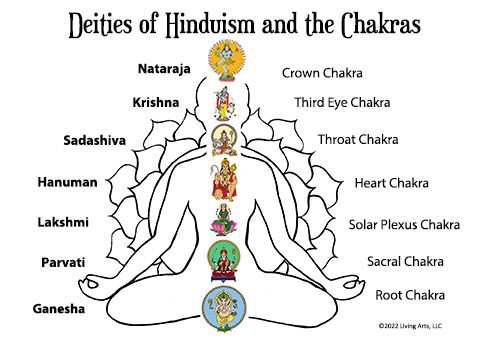Have you ever wondered which god is associated with the chakra system? In this article, we will explore the divine connections between each chakra and its corresponding deity. From the root chakra to the crown chakra, get ready to explore the spiritual realms and uncover the hidden energies that reside within you. Whether you are a believer in the chakra system or simply curious about the world of gods and goddesses, this captivating journey will surely enlighten and inspire you. So, fasten your seatbelts and prepare to discover the divine secrets hidden within the chakras.
The Concept of Chakras
Understanding Chakras
Chakras are energy centers within the body that are believed to be essential for our spiritual, mental, and physical well-being. In Sanskrit, the word “chakra” translates to “wheel” or “disk,” indicating the spinning nature of these energetic vortexes. There are seven main chakras that run along the spine, each associated with specific qualities and aspects of our being. Understanding these chakras is crucial for harnessing and channeling our energy effectively.
The Role of Chakras in Spiritual Practice
Chakras play a vital role in spiritual practice as they act as gateways that connect our physical selves to our subtle energetic bodies. By harmonizing and balancing the chakras, we can enhance our spiritual growth, emotional stability, and physical health. The chakras serve as conduits for the universal life force energy, often known as prana or chi, which flows through them. When our chakras are aligned and open, this energy can flow freely, leading to a greater sense of vitality and overall well-being.
The Seven Main Chakras
The seven main chakras are aligned along the spine, starting from the base and extending towards the crown of the head. Each chakra corresponds to specific physical, emotional, and spiritual qualities, and they can be visualized as spinning wheels of vibrant energy. Let’s explore each of these chakras in detail:
Root Chakra
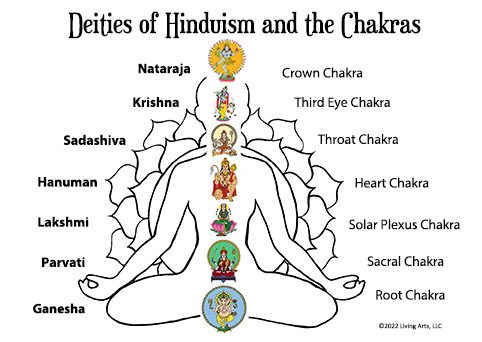
Introduction to the Root Chakra
The Root Chakra, also known as Muladhara, is the first chakra located at the base of the spine. It is associated with our connection to the earth, stability, security, and survival instincts. This chakra forms the foundation for our entire energy system, ensuring we feel grounded and rooted in our physical existence.
Symbolism and Characteristics
The Root Chakra is symbolized by a red four-petaled lotus and represents our primal instincts. It governs our sense of safety, stability, and belongingness. When this chakra is in balance, you feel secure, fearless, and at ease in your environment. An imbalanced Root Chakra may lead to feelings of anxiety, fear, and insecurity.
Associated God/Goddess
In Hindu mythology, Ganesha, the elephant-headed deity, is often associated with the Root Chakra. Ganesha represents wisdom, prosperity, success, and the removal of obstacles. Invoking Ganesha can help clear any blockages in this chakra and bring about a sense of stability and security.
Sacral Chakra
Introduction to the Sacral Chakra
The Sacral Chakra, known as Svadhishthana, is located just below the navel and is associated with our emotions, creativity, sensuality, and pleasure. This chakra governs our ability to experience and enjoy the flow of life and creative expression.
Symbolism and Characteristics
The Sacral Chakra is symbolized by an orange six-petaled lotus and represents our emotional well-being. When this chakra is balanced, you experience a healthy flow of emotions, creative inspiration, and a sense of pleasure in life. An imbalanced Sacral Chakra may manifest as emotional instability, lack of creativity, or difficulties in forming intimate connections.
Associated God/Goddess
Goddess Shakti, the embodiment of divine feminine energy, is often associated with the Sacral Chakra. She represents creativity, sensuality, and the power of manifestation. Invoking Goddess Shakti can help awaken and balance the energy in this chakra, allowing you to embrace your creativity and experience deeper emotional connections.
Solar Plexus Chakra
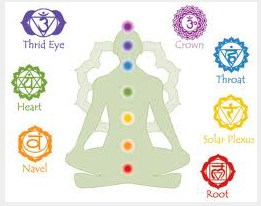
Introduction to the Solar Plexus Chakra
The Solar Plexus Chakra, known as Manipura, is located above the navel and below the chest. It is associated with our personal power, confidence, self-esteem, and inner strength. This chakra governs our sense of personal identity and autonomy.
Symbolism and Characteristics
The Solar Plexus Chakra is symbolized by a yellow ten-petaled lotus and represents our personal power and will. When this chakra is balanced, you exude confidence, have a strong sense of self-worth, and can assert yourself in a healthy manner. An imbalanced Solar Plexus Chakra may result in low self-esteem, lack of confidence, or difficulty making decisions.
Associated God/Goddess
Lord Ram, an incarnation of Lord Vishnu, is often associated with the Solar Plexus Chakra. He symbolizes courage, righteousness, and virtuous leadership. Invoking Lord Ram can help strengthen your personal power and boost your self-confidence, aiding in the balance and activation of this chakra.
Heart Chakra
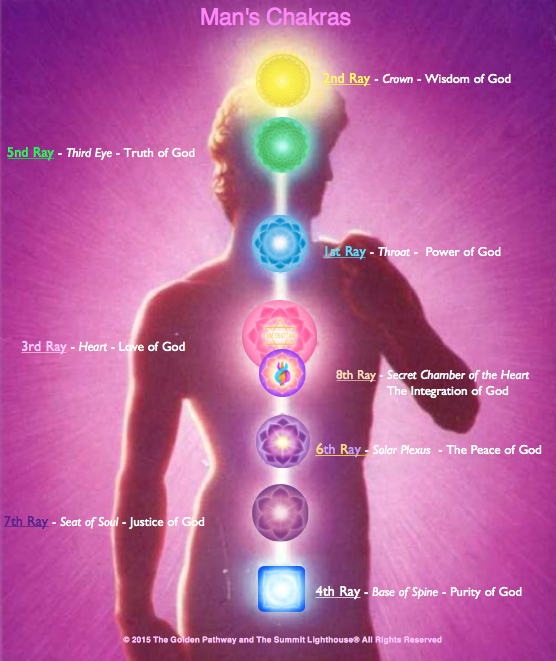
Introduction to the Heart Chakra
The Heart Chakra, known as Anahata, is located at the center of the chest and is associated with love, compassion, harmony, and forgiveness. This chakra governs our ability to give and receive love, both for ourselves and others.
Symbolism and Characteristics
The Heart Chakra is symbolized by a green twelve-petaled lotus and represents boundless love and compassion. When this chakra is balanced, you experience deep connections with others, empathy, and a generous heart. An imbalanced Heart Chakra may lead to emotional imbalance, difficulties in relationships, or a lack of self-love.
Associated God/Goddess
Goddess Lakshmi, the embodiment of divine abundance and beauty, is often associated with the Heart Chakra. She represents love, compassion, and the nurturing aspect of femininity. Invoking Goddess Lakshmi can help open your heart, cultivate unconditional love, and promote harmonious relationships.
Throat Chakra
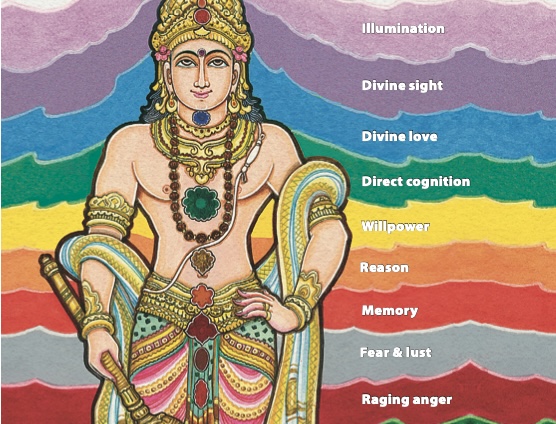
Introduction to the Throat Chakra
The Throat Chakra, known as Vishuddha, is located in the throat region and is associated with communication, self-expression, truth, and clarity. This chakra governs our ability to speak our truth and express ourselves authentically.
Symbolism and Characteristics
The Throat Chakra is symbolized by a blue sixteen-petaled lotus and represents effective communication and self-expression. When this chakra is balanced, you can express yourself honestly, speak with clarity, and actively listen. An imbalanced Throat Chakra may manifest as difficulty in expressing oneself, fear of public speaking, or frequent communication issues.
Associated God/Goddess
Goddess Saraswati, the epitome of knowledge, wisdom, and artistic expression, is often associated with the Throat Chakra. She symbolizes the power of spoken and written word. Invoking Goddess Saraswati can help balance and activate this chakra, enabling you to communicate your truth with confidence and clarity.
Third Eye Chakra
Introduction to the Third Eye Chakra
The Third Eye Chakra, known as Ajna, is located between the eyebrows in the center of the forehead. It is associated with intuition, wisdom, insight, and spiritual perception. This chakra governs our ability to tap into our inner guidance and higher consciousness.
Symbolism and Characteristics
The Third Eye Chakra is symbolized by an indigo two-petaled lotus and represents intuitive vision and clarity of thought. When this chakra is balanced, you have heightened intuition, clarity of perception, and an expanded awareness. An imbalanced Third Eye Chakra may result in a lack of clarity, difficulty making decisions, or disconnected spiritual experiences.
Associated God/Goddess
Lord Shiva, the embodiment of supreme consciousness and the destroyer of illusions, is often associated with the Third Eye Chakra. He symbolizes inner wisdom, intuition, and spiritual awakening. Invoking Lord Shiva can help activate and align the energy of this chakra, allowing you to access your inner guidance and connect with your higher self.
Crown Chakra
Introduction to the Crown Chakra
The Crown Chakra, known as Sahasrara, is located at the top of the head and is associated with spiritual connection, enlightenment, unity consciousness, and divine wisdom. This chakra governs our connection to the universal energy and our higher spiritual purpose.
Symbolism and Characteristics
The Crown Chakra is symbolized by a violet thousand-petaled lotus and represents spiritual awakening and divine connection. When this chakra is balanced, you experience a profound sense of spiritual connection, inner peace, and a deep understanding of universal truths. An imbalanced Crown Chakra may lead to feelings of disconnection, spiritual emptiness, or closed-mindedness.
Associated God/Goddess
Goddess Kali, the fierce and compassionate form of the divine feminine, is often associated with the Crown Chakra. She represents the transcendent aspect of consciousness and the power of transformation. Invoking Goddess Kali can help awaken and align the energy of this chakra, facilitating spiritual growth and the realization of one’s divine nature.
Chakra Alignment and Balance
Importance of Chakra Alignment
Aligning and balancing the chakras is essential for maintaining overall well-being and promoting optimal energy flow. When our chakras are aligned and balanced, we experience physical health, emotional stability, mental clarity, and spiritual growth. Proper chakra alignment allows for the free flow of energy throughout our entire being, leading to a sense of wholeness and harmony.
Techniques for Balancing Chakras
There are various techniques that can help balance and align the chakras, such as meditation, energy healing practices, sound healing, yoga, and breathwork. These practices focus on clearing any blockages or stagnation within the chakras, restoring their natural flow and vitality. Regular practice of these techniques can support the overall health and balance of the chakra system.
Invoking Gods for Chakra Healing
In addition to the aforementioned techniques, invoking specific gods or goddesses associated with each chakra can enhance the healing and balancing process. By connecting with these divine energies, we can tap into their qualities and channel them into our chakras, facilitating their activation and alignment. Depending on your personal beliefs and tradition, you can choose the deity that resonates most with you to assist in chakra healing.
Choosing a God/Goddess for Chakra Alignment
Personal Connection and Beliefs
Choosing a god or goddess for chakra alignment is a deeply personal journey. It is important to explore your own beliefs, traditions, and personal connection to different deities. Listen to your intuition and choose the deity that resonates with you the most. Trust that your choice will enhance your chakra healing journey and amplify the benefits of working with specific energies.
Gods/Goddesses for Each Chakra
Here is a brief overview of the gods or goddesses typically associated with each chakra:
- Root Chakra: Ganesha, the remover of obstacles and the god of prosperity.
- Sacral Chakra: Goddess Shakti, the embodiment of divine feminine energy and creativity.
- Solar Plexus Chakra: Lord Ram, the symbol of courage, righteousness, and virtuous leadership.
- Heart Chakra: Goddess Lakshmi, the goddess of abundance, love, and beauty.
- Throat Chakra: Goddess Saraswati, the goddess of knowledge, wisdom, and artistic expression.
- Third Eye Chakra: Lord Shiva, the god of supreme consciousness and spiritual awakening.
- Crown Chakra: Goddess Kali, the fierce and compassionate form of the divine feminine.
Invocation and Meditation
To invoke the chosen god or goddess for chakra alignment, you can incorporate specific prayers, mantras, or visualizations into your meditation practice. Focus on the qualities and attributes associated with the deity, inviting their energy to flow through the corresponding chakra. Visualize the chakra spinning and radiating vibrant energy, becoming balanced, and aligned.
In conclusion, understanding and working with our chakras is a transformative journey that can enrich our spiritual practice, promote healing, and enhance our overall well-being. By exploring the symbolism, characteristics, and associated gods or goddesses for each chakra, we can deepen our understanding of these energetic centers and embark on a path of inner growth and empowerment. Remember to trust your intuition when choosing a deity for chakra alignment, and embrace the divine guidance and healing that flows through this sacred practice.
